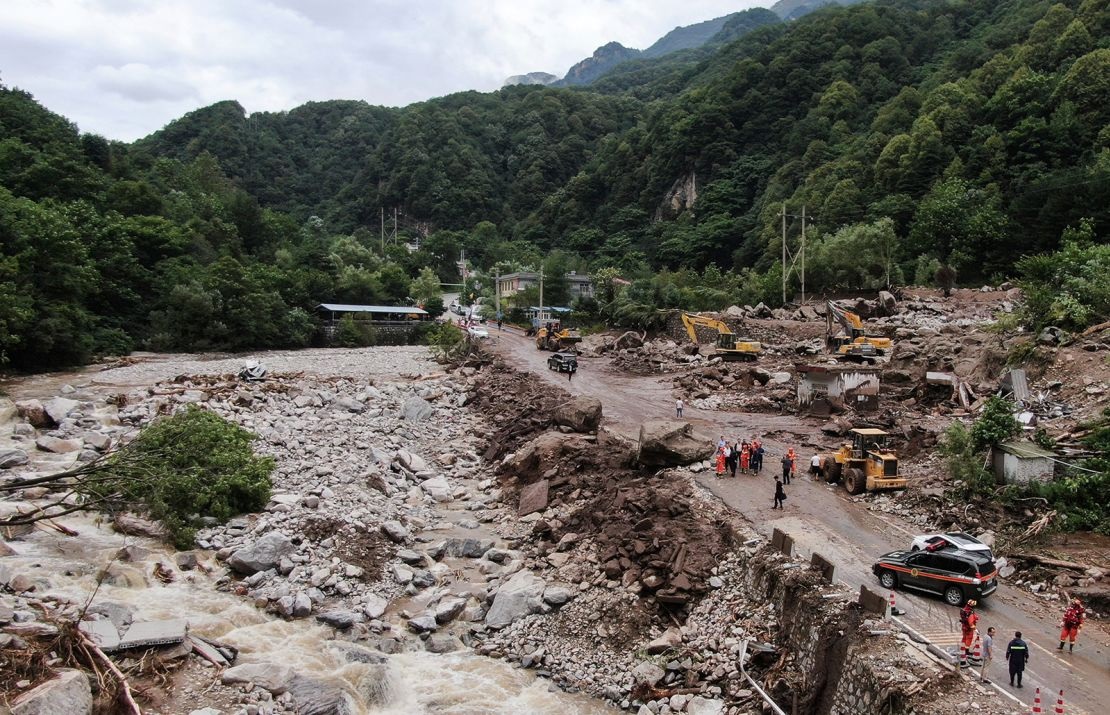News
Rain Turns Deadly: Landslide Hits Northern China

Unusually intense rainfall has triggered a deadly landslide in northern China’s Hebei province, leaving four people dead and eight others unaccounted for, according to state media, on Monday.
The incident has intensified concerns over widespread flooding as authorities in Beijing and at least 11 other provinces brace for continued extreme weather.
The landslide occurred in a rural village near the city of Chengde and was attributed to days of relentless rain, China’s state broadcaster CCTV reported on Monday.
In response, emergency teams evacuated over 4,400 residents from flood-prone areas in Beijing’s Miyun district, where flash floods and mudslides have already impacted multiple communities.
Footage and images shared on China’s popular WeChat platform revealed the scale of the destruction.
Roads in Miyun were submerged, with cars and trucks seen floating in deep floodwaters.
Entire residential buildings appeared partially underwater, and electricity outages affected more than 10,000 residents in the district.
Northern China, including Beijing and surrounding provinces, has experienced a sharp rise in rainfall over recent years.
This is reportedly an emerging pattern that scientists are increasingly linking to global climate change.
The region, traditionally drier than southern parts of the country, is now frequently exposed to water-related disasters.
China’s Central Meteorological Observatory has forecast that heavy rains will continue to pound the north over the next three days.
In response, the Ministry of Water Resources has issued flood risk alerts across 11 provinces and regions, signaling the potential for further disasters.
On Monday, Beijing raised its flood alert to the highest emergency level, according to state news agency Xinhua.
In Hebei province, where the landslide took place, national emergency authorities have deployed inspection teams to assess what they describe as “severe” flooding conditions.
The neighboring province of Shanxi is also under pressure.
Video footage shared by state-run outlets showed flooded streets, submerged farmland, and rising waters threatening residential zones.
Flash flood warnings were also issued across parts of Shanxi, home to the culturally significant city of Xian.
The flooding crisis comes amid a broader wave of extreme weather events sweeping across China, largely driven by the East Asian monsoon.
The resulting damage and disruptions are putting strain on public infrastructure and the national economy, which is already grappling with slower post-pandemic recovery.
In response to the growing crisis, China’s National Development and Reform Commission announced on Monday that it is allocating emergency relief funds.
Approximately 50 million yuan (about $7 million) will be directed to Hebei province for disaster recovery.
The funding will go toward rebuilding essential infrastructure, including roads, bridges, water control barriers, schools, and hospitals.
Natural disasters are a recurring challenge in China.
These come particularly during summer months when the country faces a mix of torrential rains in some regions and intense heatwaves in others.
Climate variability has further complicated disaster prevention and mitigation efforts.
The recent calamity in Hebei is not an isolated case.
Earlier in July, flash floods in eastern Shandong province claimed two lives, with ten individuals reported missing.
Similarly, in Sichuan province, a landslide swept vehicles off a highway, resulting in five deaths.
These events underline a troubling trend of increasingly frequent and deadly natural disasters across the country.
Authorities continue to urge residents in affected areas to remain vigilant, avoid travel when possible, and heed emergency alerts.
In urban centers, local governments are mobilizing resources to reinforce drainage systems, bolster river embankments, and provide shelter for those displaced.
As climate patterns grow more erratic, experts warn that China must invest more aggressively in climate-resilient infrastructure and disaster preparedness.
The rising human and economic toll of natural disasters underscores the urgent need for long-term planning and international cooperation to mitigate the effects of global warming.
For now, however, much of northern China remains on high alert as heavy rain shows little sign of abating.
Also, the risk of additional landslides, floods, and displacement remains dangerously high.
For Diaspora Digital Media Updates click on Whatsapp, or Telegram. For eyewitness accounts/ reports/ articles, write to: citizenreports@diasporadigitalmedia.com. Follow us on X (Fomerly Twitter) or Facebook










